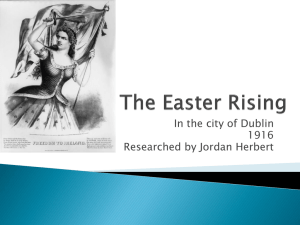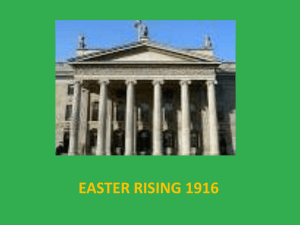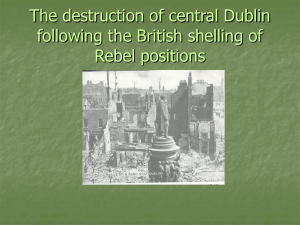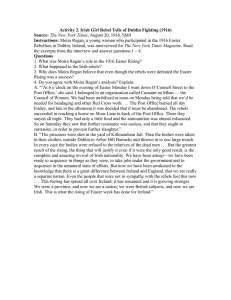Lecture 9 Rising and Revolution: 1916 and After
advertisement
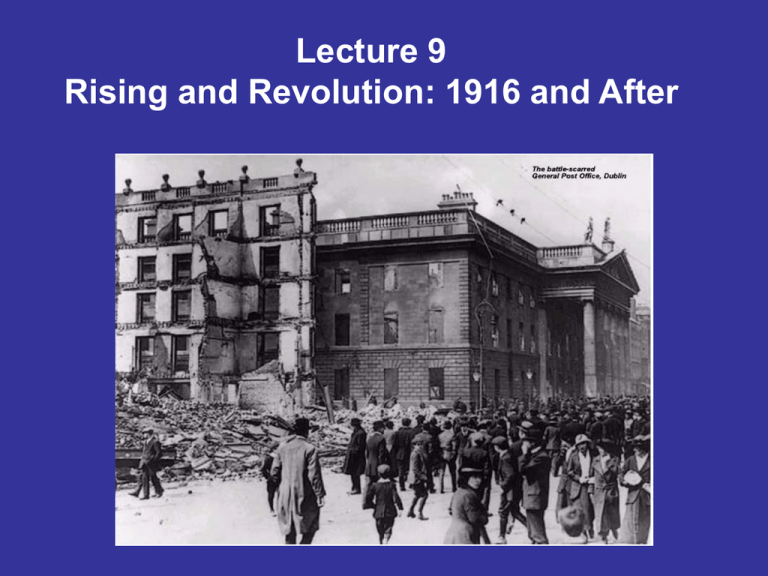
Lecture 9 Rising and Revolution: 1916 and After Easter Rising – debate & controversy • The planning of the insurrection • The rising as blood sacrifice • Public opinion and the rising I. Easter 1916 • • • • • • Origins Planning the insurrection The course of the rising 1916: Coup or sacrifice? The British response to the rising Public opinion and the rising II. Ireland Post-1916 • Sinn Féin gains ground • The Irish Convention • The Conscription Crisis • General Election 1918 and the establishment of Dáil Éireann • Emergence of the IRA Easter Rising - Origins • Cultural nationalism • A series of social, political and military crises • The failure of Home Rule • British governance • First World War • War weariness • Blocked mobility thesis Easter 1916 • The Rising began on Easter Monday, 24 April • Approximately 1,000 Volunteers and 200 members of the Irish Citizen Army seized the General Post Office and other sites in Dublin • The rebels surrendered on April 29. • Supporting action also took place in Wexford, Galway and Co. Dublin. • In Dublin 64 insurgents, 132 crown forces and 230 civilians were killed. • Extensive use of artillery devastated much of Dublin’s city centre. British army officers pose beneath the statue of Parnell with the ‘Irish Republic’ flag that had flown over the GPO in O’Connell Street during Easter week, 1916 Constance Markievicz ‘Mug shot’ of Constance Markievicz after her arrest following the Easter Rising British troops firing at the GPO during Easter week British response to 1916 • Fifteen rebel leaders executed in early May • Executions carried out in a protracted, semisecret manner • Martial law was imposed indefinitely under a Military Governor, General Maxwell • Civilians were dealt with under the statutory powers of the Defence of the Realm Act (DORA) • Heavily armed mobile columns arrested 3340 men and 79 women throughout Ireland Public Opinion and Easter 1916 • ‘The consensus among historians is that an initially hostile public opinion was transformed by the executions into retrospective support for, and romanticisation of, the rebels.’ Lee, Ireland 1912-1985 pp28-29. Public Opinion and Easter 1916 • Not easy to gauge • Initially the middle classes sided with the government • The attitude of the lower classes has been described as more complex and uncertain • Public opinion had begun to shift by mid May • Unfriendliness or hostility towards the police • Sympathy for the rebels increased Public Opinion and Easter 1916 Difficult to decipher whether, as Townshend puts it, ‘opinion was ‘transformed’ from hostility to sympathy…or…‘crystallised’ (meaning that a latent sympathy was solidified).’ Townshend, Easter 1916: The Irish Rebellion p307. Public Opinion and Easter 1916 ‘The city is quiet now, but there is a very menacing tone among the lower classes who openly praise the Sinn Féiners for their courage and bravery, and there is a lot of abuse of the soldiers. At the same time the latter seem to be popular, at least with the female population. The sympathies of the ordinary Irish are with Sinn Féin. They want independence and their only criticism of the rebellion is that it was foolish (not criminal or otherwise wrong), but just foolish because it had no chance of success.’ AM Bonaparte-Wyse quoted in Lee, Ireland 19121985, p32. Sinn Féin • Rising referred to inaccurately as the Sinn Féin rebellion • SF benefited from this – sparked curiosity about the organization • SF became a militant nationalist movement post 1916 • A coalition of radical republicans and moderate nationalists Emergence of the IRA • Easter Rising left the Irish Volunteers in disarray • October 1917: it was decided that the Volunteers were to be used to exert political pressure on the British government to recognize the Irish republic • The Volunteers began to arm, train and organise. With the establishment of Dáil Éireann in Janaury 1919 they became known as the Irish Republican Army (IRA) • The IRA became the official army of the new republic
